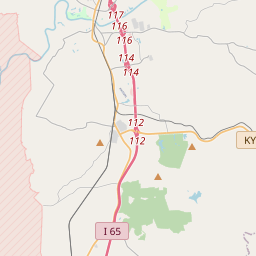Morgan-on to Ohio







July 7, 1863, Morgan's CSA Cavalry arrived here, captured steamers John B. McCombs and Alice Dean. Next day they began crossing river. Indiana militia fired on them but fled under return fire. Alice Dean burned after crossing. Morgan went on to northeastern Ohio, where he surrendered July 26. Imprisoned at Columbus, Ohio, he escaped Nov. 24, returned south.
Erected February 15, 1963
April 12, 1861: The Civil War begins with the Confederate attack on Fort Sumter, located in South Carolina's Charleston Harbor.
April 15, 1861: President Abraham Lincoln issues a call for 75,000 volunteers to serve in the Union Army to suppress the rebellion.
May 24, 1861: The first major land battle, known as the First Battle of Bull Run (or First Battle of Manassas), takes place in Virginia. It ends in Confederate victory.
September 17, 1862: The Battle of Antietam in Maryland becomes the bloodiest single-day battle in American history, with heavy casualties on both sides. The Union forces, commanded by General George McClellan, manage to halt Confederate General Robert E. Lee's advance into Union territory.
January 1, 1863: President Lincoln issues the Emancipation Proclamation, declaring that all slaves in Confederate-held territories are to be set free. However, the proclamation does not immediately free all slaves in the United States.
July 1-3, 1863: The Battle of Gettysburg in Pennsylvania takes place, resulting in a significant Union victory and inflicting heavy casualties on Confederate forces. It marks a turning point in the war.
November 19, 1863: President Lincoln delivers the Gettysburg Address, emphasizing the principles of liberty, equality, and the preservation of the Union.
April 9, 1865: General Robert E. Lee surrenders to Union General Ulysses S. Grant at Appomattox Court House in Virginia, effectively ending the Civil War.
April 14, 1865: President Lincoln is assassinated by John Wilkes Booth while attending a play at Ford's Theatre in Washington, D.C.
May 10, 1865: Confederate President Jefferson Davis is captured, signaling the collapse of the Confederate government.
December 6, 1865: The Thirteenth Amendment to the United States Constitution is ratified, officially abolishing slavery throughout the country.
While this timeline provides an overview of key events, it is important to note that the Civil War spanned over four years, from 1861 to 1865, and encompassed numerous battles, campaigns, and political developments that shaped the course of American history.
The famous African-American author and poet, Langston Hughes, spent much of his childhood in Lexington, Kentucky.
In the mid-19th century, Meade County experienced significant growth due to the flourishing steamboat industry. The Ohio River served as a major trade route, and the county's ports and landing sites became bustling centers of commerce. The arrival of the Louisville and Nashville Railroad in the 1880s further boosted the county's economy and allowed for easier transportation of goods and people.
During the Civil War, Meade County played a strategic role due to its geographical significance. Both Union and Confederate forces vied for control over the area, leading to several skirmishes and battles. Notably, the Battle of Brandenburg, fought in 1861, witnessed Union victory and marked a turning point in the war in Kentucky. Today, Meade County prides itself on preserving its Civil War history through various historical sites and monuments.
In the 20th and 21st centuries, Meade County continued to evolve economically and socially. The establishment of Fort Knox, a U.S. Army post, in 1918 brought military influence and economic stability to the county. Fort Knox remains an integral part of Meade County, providing jobs and supporting the local economy. Over the years, the county has seen increased investment in industries such as agriculture, manufacturing, and tourism.
Overall, Meade County's history is one of growth, resilience, and adaptation to changing times. Today, it continues to be a vibrant community that celebrates its past while embracing the opportunities of the future.
Meade County Timeline
This timeline provides a glimpse into the major events and milestones that have shaped the history of Meade County, Kentucky.
- Meade County was formed on December 17, 1823.
- In 1813, the Battle of Tippecanoe took place, which involved soldiers from Meade County.
- During the Civil War, Meade County was a strategic location due to its proximity to the Ohio River.
- In 1862, Confederate General John Hunt Morgan's troops raided and briefly occupied Brandenburg, the county seat.
- In 1935, the Ohio River flood caused significant damage to Meade County.
- In the early 1940s, the United States Army established Camp Breckinridge in Meade County as a training base during World War II.
- In 1950, the construction of the United States Bullion Depository (Fort Knox) began, providing significant employment and economic opportunities for Meade County.
- In recent years, Meade County has experienced growth in population and development.